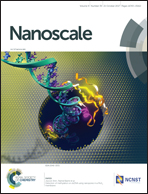Compositional tuning in sputter-grown highly-oriented Bi–Te films and their optical and electronic structures
Abstract
Growth of Bi–Te films by helicon-wave magnetron sputtering is systematically explored using alloy targets. The film compositions obtained are found to strongly depend on both the sputtering and antenna-coil powers. The obtainable film compositions range from Bi55Te45 to Bi43Te57 when a Bi2Te3 alloy target is used, and from Bi42Te58 to Bi40Te60 (Bi2Te3) for a Te-rich Bi30Te70 target. All films show strong orientation of the van der Waals layers (00l planes) parallel to the substrate. The atomic level stacking of Bi2Te3 quintuple and Bi bi-layers has been directly observed by high resolution transmission electron microscopy. Band structure simulations reveal that Bi-rich Bi4Te3 bulk is a zero band gap semimetal with a Dirac cone at the Gamma point when spin–orbit coupling is included. Optical measurements also confirm that the material has a zero band gap. The tunability of the composition and the topological insulating properties of the layers will enable the use of these materials for future electronics applications on an industrial scale.



 Please wait while we load your content...
Please wait while we load your content...